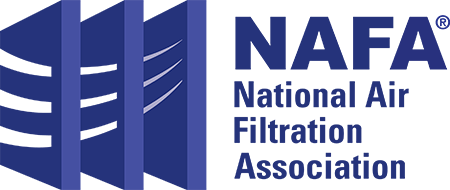NAFA Position Statement on ASHRAE’s Epidemic Task Force (ETF) Core Recommendations for Reducing Infectious Aerosol Exposure
May 26, 2021
The National Air Filtration Association (NAFA) is pleased to offer its’ support and feedback to ASHRAE’s Epidemic Task Force (ETF) for the outstanding document “Core Recommendations for Reducing Airborne Infectious Aerosol Exposure”. To complete this document in such a short period of time, and for it to be so universally accepted and referenced by the HVAC industry, governments, and all the major health agencies, such as, WHO, CDC, and EPA, is an extraordinary feat.
Much of the guidance offered in the document follows existing ASHRAE guidelines and standards such as 62.1-2019 “Ventilation for acceptable Indoor Air Quality”. NAFA endorses the ETF’s recommendation for the significant increase in filter efficiency from a MERV (minimum efficiency reporting value) 8 to a MERV 13 or higher. NAFA is cognizant of the increased pathogen capture performance features of MERV 13 and higher filters and the ETF’s recommendation is consistent with NAFA’s “Guidelines for Commercial Office Spaces” published in 2012.
NAFA’s focus is Education, Expertise, and Certification in the field of air filtration. The following are key factors that should be considered when upgrading filter efficiency from MERV 8 to MERV 13 as we believe they will complement the overall ASHRAE document.
- Filter system efficiency is not the same as filter efficiency. The two equally important elements in filter performance are the filter itself and the holding apparatus/framework that the filter sits in. As you increase in filter efficiency the importance of a properly sealed filter and holding apparatus/framework is critical and must be addressed. High efficiency filters will not perform as intended if they are not sealed properly and air allowed to bypass them. Dr. Jeffrey Siegel’s 2005 research revealed that a 1 mm gap can lower the MERV rating on a high efficiency filter by one point and a larger 10 mm gap can reduce a MERV 15 filter to a MERV 8. (1) The goal must be filter system efficiency not just the filter’s MERV rated efficiency. We recommend having a trained certified air filtration specialist/IAQ technician verify that your filter efficiency and filter system efficiency are one and the same.
- Filter service must be handled with care and attention. Selection and servicing high efficiency HVAC filters is a specialty task that should only be performed by industry trained technicians. Filter service technicians should have extensive knowledge of all safety protocols, especially the use of the proper Personal Protective Equipment (PPE), as well as the understanding of filter disposal in a safe manner. Since it is accepted that the SARS CoV-2 virus is airborne, and published studies have shown that air filters can capture this virus, we can rationally assume that the filters may be contaminated with viable SARS CoV-2 virus. Having a NAFA certified technician, or industry trained in-house staff, reduces potential risk and liability. NAFA offers the NAFA Certified Technician (NCT) program to educate your service personnel. NAFA has also published “The Installation, Operation, and Maintenance of Air Filtration Systems” as a guide for filter servicing protocols. Contact your local NAFA Certified Air Filtration Specialist (CAFS) or www.NAFAHQ.org for course details.
- Lessons learned not to be repeated. The Covid-19 pandemic has made us aware of the critical importance of mechanical systems in providing healthy air in our most vulnerable facilities, such as, Schools and Continuing Care. Capital Infrastructure improvements are planning the upgrading and replacement of an unprecedented number of HVAC equipment for these and other facilities. Merely replacing these systems with newer versions is not enough. During this crisis there have been concerns about upgrading to a higher MERV filter due to an increase in pressure drop, an increase in energy, and reduced airflow. At NAFA we understand these concerns and recognize that it is not always possible to upgrade filters in existing systems. Addressing these concerns in new systems requires a conscious effort to improve air filtration specifications at the design stage. New air filter technologies, oversizing filter banks, and increasing the available depth of filter banks can safely address these concerns. Adding a second filter bank that can be mobilized for an extraordinary incident enables a facility to be proactively prepared for the next pandemic or wildfire smoke event. If we start today, we will not be having this same conversation 20 years from now.
- Supplemental Air Cleaning Technologies. The SARS CoVid-19 pandemic has increased the number of companies selling “new technology” air cleaning products that purport to remove, destroy, or inactivate the SARS CoV-2 virus. It is NAFA’s position that any technology making such claims be supported by third party, peer reviewed, performance documentation. If the decision is made to purchase one of these technologies be confident that you understand the benefits, potential risks, and impact on building occupants of any new air cleaning technology. A NAFA Certified Air Filtration Specialist (CAFS) can assist you with your options and help you make an informed decision based on your budget and goals.
Ventilation, Filtration, and Indoor Air Quality have been three of the most important organizational health and safety issues discussed since the pandemic began. This heightened awareness will not diminish but will become the new benchmark for indoor environments. Some of these strategies discussed may increase energy consumption and capital spending, however, the benefits will be a healthier and more productive environment for all who live, visit, work, and play in these facilities.
(1) Modeling filter bypass: Impact on filter efficiency, Dr. Jeffrey Siegel, Matthew Ward ASHRAE Transactions; Atlanta Vol. 111, (2005): 1091-1100.
